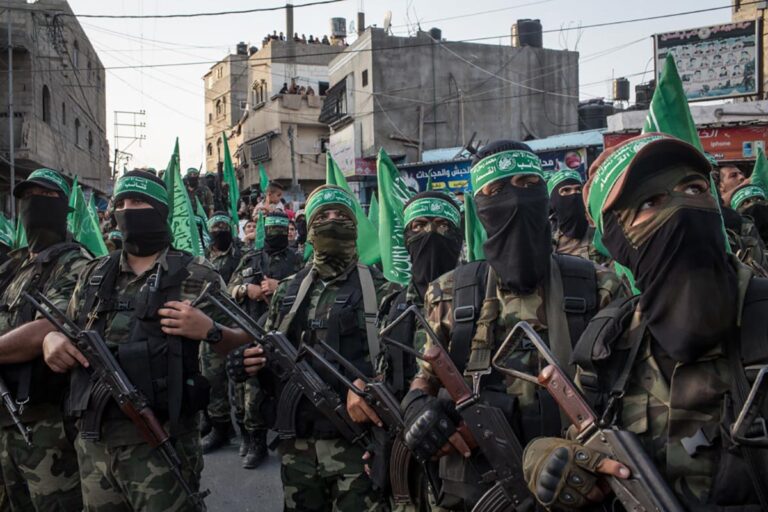
Hamas is a fundamentalist Islamic terrorist group that has waged war on Israel since its founding in the 1980s. It aims to destroy Israel and its people in order to create a Palestinian state. Currently, Hamas governs the Gaza Strip with a fundamentalist form of religious doctrine.
On October 7, 2023, Hamas launched an unprecedented attack on Israel that killed more than 1,400 people, making it the deadliest attack in Israeli history. Hamas invaded towns and IDF bases, murdering and kidnapping hundreds of civilians and soldiers, including children and infants. Read more about Hamas’ shock attack on Israel.
The Iran-backed terror group was also behind a wave of devastating suicide bombings and other activities in the 1990s and 2000s, including 40% of attacks during the Second Intifada, which claimed the lives of over 1,000 Israelis.
More recently, Hamas has launched thousands of rockets at Israel, dug attack tunnels in order to infiltrate Israeli communities, and inspired countless lone-wolf attacks on Israeli soldiers and civilians.
Here’s what you need to know about Hamas and its ongoing attack on Israel.
What is Hamas? A deeper dive
Hamas is an acronym for Harakat al-Muqawama al-Islamiya (meaning “Islamic Resistance Movement”).
Their charter calls for the destruction of the Jewish state of Israel (and its people) in order to create an independent Palestinian religious state that covers the entirety of Israel.
They consider the region of Palestine as spanning the entire state of Israel, not only the disputed territories of the West Bank and Gaza. According to Hamas, the region of Palestine is an Islamic waqf, a religious endowment granted by God, which can’t be surrendered or shared with members of other religions. That’s why Hamas refers to any Israeli presence in the region as an occupation.
In its continual attack on Israel, Hamas has committed unspeakable atrocities against civilians, killing babies, women, children and families, many in barbaric ways, and raping and abusing women.
The group has long celebrated anyone who commits a suicidal act in order to harm Jews as a “shahid” or a martyr. The group rewards each shahid’s death, showering their families with monetary funds and status.
Is Hamas a terrorist organization?
Hamas is designated as a terrorist group by the U.S., Canada, the European Union, Israel, Japan, Paraguay, and the U.K.
The group is divided into three parts: a network of social organizations, including schools and hospitals in the West Bank and Gaza Strip; a political division; and an armed militia wing, the Izz ad-Din al-Qassam Brigades, that carries out suicide bombings and attacks against Israel.
However, many argue the arms of Hamas cannot be separated. “Hamas exists for one reason: to destroy the state of Israel,” explained Jonathan Schanzer, the Soref fellow at The Washington Institute on Near East Policy and an expert on radical Islamic movements.
Where did Hamas come from?
Hamas was formed in 1987 as an outgrowth of the Muslim Brotherhood, an Islamist political group founded in Egypt in the late 1920s.
Established in 1928 by an Egyptian schoolteacher and Imam named Hassan al-Banna, the Muslim Brotherhood began as a movement to combat social issues and resist Western secularization through a fundamentalist Islamic approach.
While peaceful at first, the Brotherhood escalated to political violence in the 1940s, bombing buildings and assassinating Arab leaders. In 1954, the Brotherhood tried and failed to assassinate Egypt’s president Gamal Abdel Nasser, causing the government to arrest thousands of Muslim Brotherhood members, including a Palestinian named Ahmed Yassin.
Yassin was eventually released from Egypt. By 1968, he returned to Gaza and created the Muslim Brotherhood branch in Gaza and the West Bank. Initially, this arm of the Brotherhood was focused on building mosques and providing services to Palestinians.
However, by the late 1970s, an Islamic Revolution inspired by new radical leadership in Iran shook the Muslim world. Imams in Gaza, including Sheikh Yassin, grew more and more radical, preaching “armed struggle” in the name of Islam.
In 1987, Yassin united the Muslim Brotherhood presence in Gaza and unveiled the new Hamas movement.
How did Hamas gain control of Gaza? And where do other Palestinian political organizations fit in?
Hamas has been the de facto authority in Gaza since shortly after Israel withdrew from the territory in 2005.
Until then, nearly 9,000 Jews called the Gaza Strip home. But in 2005, then-Prime Minister Ariel Sharon made the highly controversial decision to remove all Israeli settlements from Gaza. The bloc of Jewish settlements in the southern Gaza Strip was known, collectively, as Gush Katif.
At the time, many Palestinians were frustrated with the corruption of the ruling party, Fatah (the largest faction of the confederated multi-party Palestine Liberation Organization or “PLO”). As a result, they turned to Hamas, the only Palestinian party that seemed to care about them.
In the 2006 Palestinian elections, Hamas won a majority of seats in the Palestinian Authority’s legislature and formed a government. The leader of Hamas, Ismail Haniya, was appointed prime minister.
The rivalry between Hamas and Fatah resulted in violence, and their agreement to form a national unity government fell apart. Hamas conducted a bloody coup and took control of Gaza, while Fatah continued to control the Palestinian Authority in the West Bank.
But if Palestinians were hoping that Hamas would make their lives better, they grew more and more disillusioned with every passing year.
Hamas receives large sums of money from various sources, including the UN, Qatar, and most significantly, Iran. But most of this cash goes towards buying weapons and digging tunnels from which to attack Israel.
Hamas now governs over 2 million Palestinians under fundamentalist religious doctrine with no freedom of speech, press, religion, and more. Palestinians have not voted for a legislature since 2006, nor a president since 2008.
Who leads Hamas today?
Hamas has multiple leadership bodies that perform different political, military, and social functions.
Ismail Haniyeh currently serves as political chief of Hamas, having replaced longtime leader Khaled Meshaal in 2017. Haniyeh has operated from Doha, Qatar, since 2020, reportedly because Egypt restricts his movement into and out of Gaza.
Hamas leaders established a presence in Qatar after falling out with their previous host, Syria, when Palestinian refugees participated in the 2011 uprising that preceded the Syrian Civil War. Some senior Hamas figures reportedly operate out of the group’s offices in Turkey.
Today, many of Hamas’ leaders live in luxury in these countries, allegedly using Hamas funding to finance their extravagant lifestyles, while Palestinians in Gaza live in poverty.
Yahya Sinwar — who previously headed Hamas’s military wing and served 22 years in Israeli prison for masterminding the abduction and killing of two Israeli soldiers in 1989 — oversees the day-to-day affairs in Gaza. He was among the more than 1,000 Palestinian prisoners freed in 2011 in exchange for Israeli soldier Gilad Shalit, who was held by Hamas.
Where does Hamas get its funding?
As a designated terrorist group, Hamas is cut off from official assistance that the U.S. and EU currently provide to the PLO in the West Bank.
Instead, Hamas receives its funding from the United Nations, Qatar, Iran and Palestinian expatriates and private donors.
Iran is one of Hamas’s biggest benefactors, contributing funds, weapons, and training. Iran currently provides some $100 million annually to Hamas, most of which goes toward buying weapons and digging tunnels from which to attack Israel.
Hamas’s growth as a terror organization
Hamas has used violence and terror against Israel since its inception. Their first act as an organization was the kidnapping and murder of two Israeli soldiers in 1989.
After this, determined to get rid of Hamas, the IDF deported all known members to southern Lebanon.
This is where they met Hezbollah — another terrorist group sworn to Israel’s destruction. Hezbollah, which had been created and trained by the Iranians, taught Hamas everything they had learned from the Iranian Revolutionary Guard: encryption and codes, espionage, how to use a rocket launcher and make a bomb. Read more about Hezbollah.
Eventually, Israel caved to international pressure and brought the Hamas men back into Gaza. Within a year, a Hamas fighter, Yahya Ayyash nicknamed “the engineer” used his Hezbollah training to engineer the first suicide bombing attack in Israeli history.
Through the early 90s, Hamas conducted suicide bombings at buses and bus stops, malls, cafes, and marketplaces, inflicting permanent terror and trauma on Israeli society.
After Israel and the PLO signed the first of the Oslo Accords in late 1993, Hamas — along with other terror groups — responded with a wave of attacks. Between 1994 and 1999, Hamas and Islamic Jihad carried out 25 terror attacks.
During the Second Intifada from 2000 to 2005, Israelis endured near-daily terrorist attacks, largely suicide bombings. Hamas was responsible for 40% of these attacks with the other 60% coming from other Palestinian terror groups, like Palestinian Islamic Jihad and the Al-Aqsa Martyrs’ Brigade, the military wing of Fatah.
On October 7, 2023, now known as Black Saturday, Hamas launched an unprecedented surprise attack against Israel. The attack took place one day after the 50th anniversary of the Yom Kippur War, mirroring the shock and horror of that conflict in which Israel was also caught off guard.
Hamas terrorists waged a multifront attack, invading Israel by land, sea, and air. Hundreds of terrorists infiltrated Israel with trucks, boats, and paragliders. Within hours, thousands of rockets were fired at Israel with several landing and causing civilian casualties.
This attack is the deadliest in Israel’s history and the deadliest 24 hours in Jewish history since the Holocaust.
In its ongoing attack on Israel, Hamas has committed unspeakable atrocities against civilians, killing babies, women, children and families, many in barbaric ways, and raping and abusing women.
